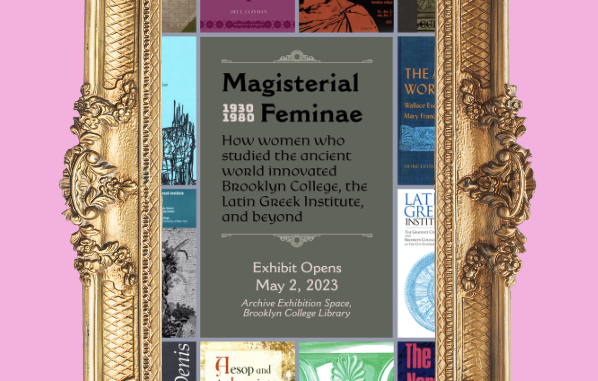
By Gabriela Flores
Stretching across the first five decades of Brooklyn College’s inception, the “Magisterial Feminae” exhibit is set to debut on Tuesday, May 2. At its core, the curated archival material will feature the brilliant women professors who reimagined the college’s humanities, helped establish the internationally recognized Latin/Greek Institute, and aided communities beyond campus.
“I think the exhibit is making a really big argument to everyone in the college that the humanities is something that is alive and well here,” Associate Professor of History Lauren Mancia, the exhibit’s co-curator, told The Vanguard.
The “Magisterial Feminae” showcases archival materials from 1930 to 1980, when the presence of women in academia and American society underwent drastic changes. With the help of the college’s archivists, including Marianne LaBatto, Mancia, and co-curator Professor Lucas Rubin, the director of the Latin/Greek Institute and assistant dean for academic programs, all sought to pay homage to BC’s humanities pioneers and their contributions. The exhibit specifically highlights female pre-modernist professors who studied the world before the year 1500, and how their work could still be applicable to today’s liberal arts education and society.
“I felt that the least that I could do was sort of lend my voice to honor some of the stuff that they did. I feel in a way we just touched the tip of the iceberg for stories to be told,” said Rubin, noting that he felt humble at times while looking through the college’s archives.
Pre-modernism spans multiple academic disciplines, including art, political science, modern language, and others. This diversity is embodied by the college’s 23 faculty members who form part of different departments at Brooklyn College and the Late-Antique-Medieval-Early-Modern working group.
Contrary to what many today might think, studying the pre-modern could be beneficial to better understand the present moment. Increasingly, however, the humanities and its consideration of the past have not received the same recognition or support as programs rooted in STEM.
“I feel like we’re gaining more tools but losing our purpose as people,” said student David Paré, who is majoring in physics at BC and forms part of the student research team that aided Mancia and Rubin in organizing the exhibit. While seeing archived photographs and articles, Paré had a common thought, “I can’t help but think these were the glory days, but now they’re behind us.”
In celebrating the humanities, the exhibit also pays respects to the Latin/Greek Institute’s 50th anniversary and the women who implemented changes that still radiate today. These homages to pre-modernist women professors came about after searching the archived material and seeing what they had to offer. When they officially began working on the “Magisterial Feminae” together in January, Mancia, Rubin, and the student researchers searched through the catalogs, finding fragments of the past. From a syllabus on matrimony to an early journal of women’s studies, the archived materials were abundant. For an exhibition’s sake, this vast information was filtered mostly by the students, and how the co-curators envisioned telling a succinct sequence of the changes and challenges that the women professors experienced decades ago.
“Part of what the exhibit does is that through the lens of women, shows their perseverance, shows them adhering to the values that they had. And shows that despite that adversity, transformed the college,” said Mancia.
Using humanities skills of taking fragmented narratives and recovering history, the students and professors were able to dissect what was important for the exhibit’s premodernity crux. The analyzed time period, 1930 to 1980, also had two crises: World War II, as well as CUNY’s 1970s budget crisis and open admission struggles. With the wealth of material they had, and their intent to also contextualize the experiences of women during that time, the co-curators condensed what would usually take hundreds of pages to explain into a concise, visual space of an exhibition.
“Sometimes when you’re too close to the material, it’s very hard to go up to 20,00 feet and say, ‘It’s actually really important,’” said Rubin, noting Paré and other students played an important role in the exhibit’s organization.
One of the pivotal figures in Brooklyn College history who’ll be showcased in the exhibit is Ethyle R. Wolfe, a classicist professor, BC administrator, and trailblazing leader for the college’s humanities. Wolfe played a significant role in the Latin/Greek Institute, the Humanities Institute that is named in her honor, and the Core Curriculum, a former program at Brooklyn College that unraveled interdisciplinary skills for students.
The exhibit will also showcase pre-modernist women professors who did not receive much time in the spotlight, including Professor Rita Fleischer, who taught Professor Rubin Latin and has a strong presence at his institute. Marion Starling, a BC professor who was the first to write a dissertation on slave narratives in 1947, will also be included in the exhibit.
“In some way, this exhibit is a kind of acknowledgment of our ancestors at Brooklyn College. As a female faculty member, I feel this very acutely,” said Mancia. “That these are the women who went through a lot of pain so that I could go to graduate school. These are the women who went through a lot of pain so I could be at the front of the classroom, and men would listen to what I say and respect my authority.”
While showcasing the historical efforts of women pre-modernist professors through their exhibit, the organizers aim to show how versatile the humanities can be for critical thought, future careers, and innovation.
“I think innovation also comes from looking at history and appreciation of history, appreciation of the foundation, is also part of our responsibility as human beings,” said Mancia.
The exhibit will run from May 2 through December on the library’s first floor by the Special Collections.
